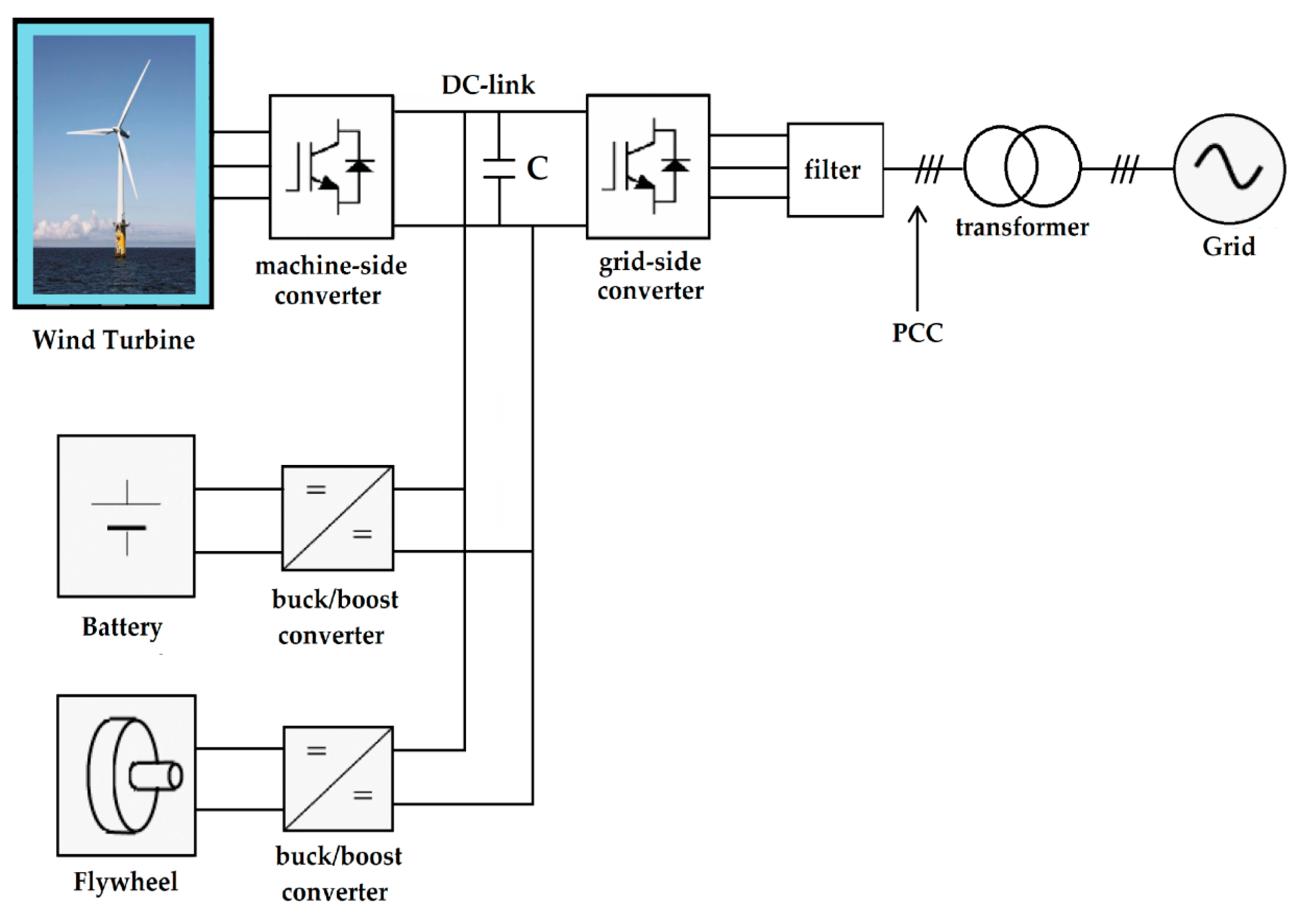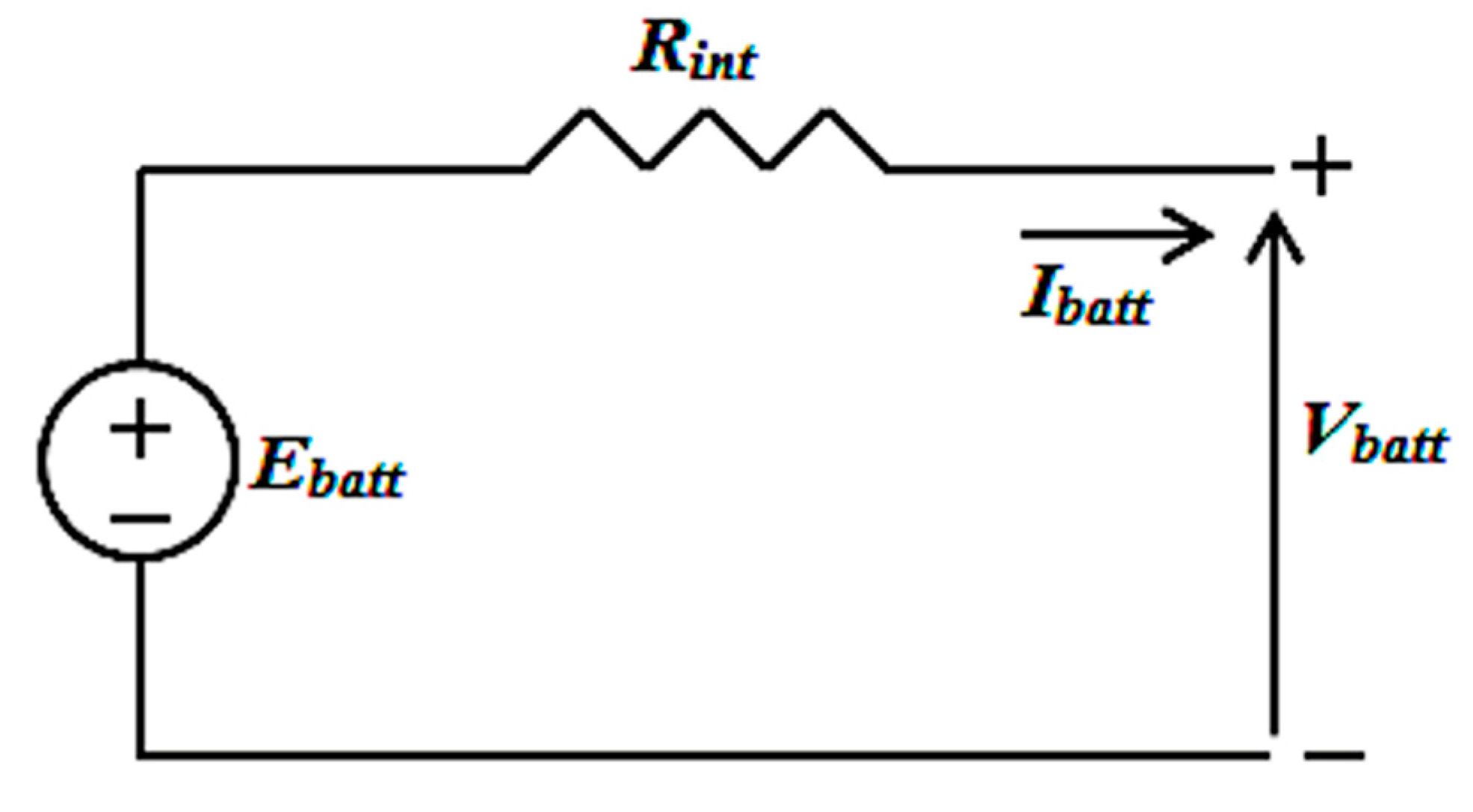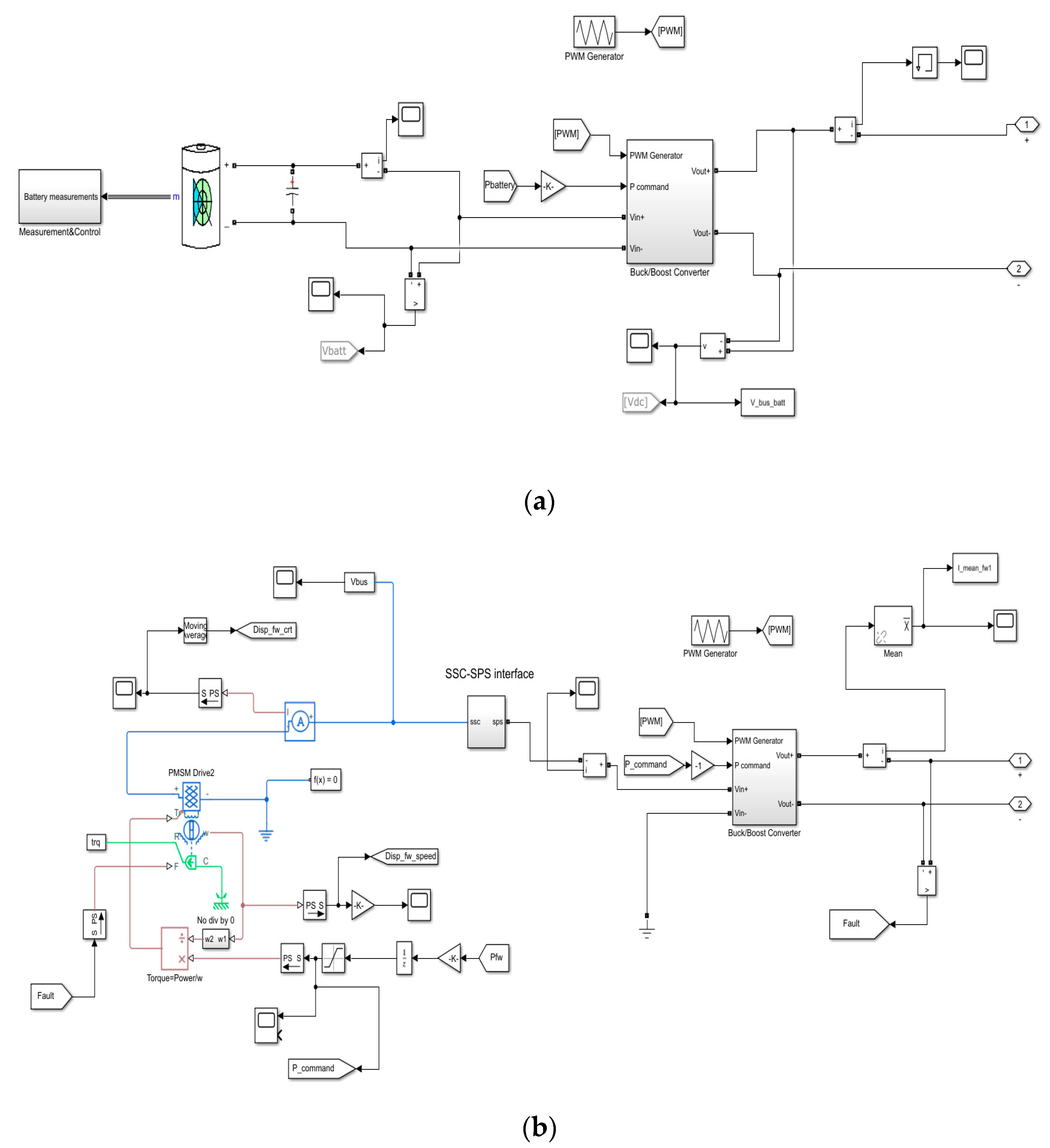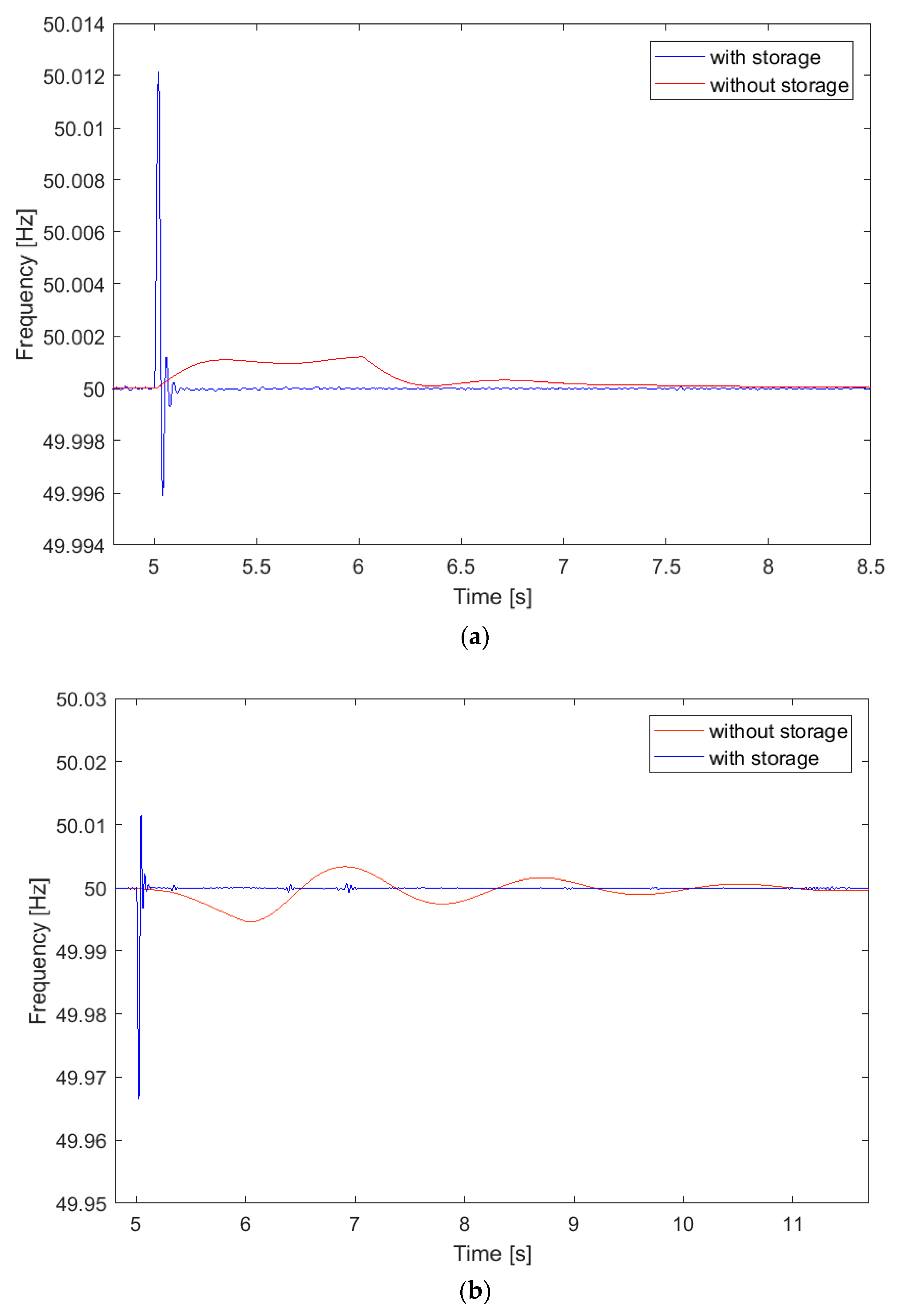HESS in a Wind Turbine Generator: Assessment of Electric Performances at Point of Common Coupling with the Grid
Abstract
:1. Introduction
- (i)
- Investigate the electric performances at the PCC of a Li-ion battery/flywheel HESS coupling to an offshore WEC, which is interfaced with the grid by means of a full-scale back-to-back converter;
- (ii)
- Confirm the effectiveness of the Simultaneous Perturbation Stochastic Approximation (SPSA) power management strategy for smoothing the wind power generation;
- (iii)
- Compare the behavior of the offshore WEC in the presence/absence of the HESS in terms of transient time and amplitude of the voltage waveform frequency at the PCC under severe wind turbine operating conditions in terms of the produced power ramp.
2. Model Description
2.1. Wind Turbine Section
2.2. HESS Section
3. Definition of Different Scenarios
- -
- Day 1: maximum bandwidth;
- -
- Day 2: maximum mean power;
- -
- Day 3: maximum bandwidth-to-mean power ratio;
- -
- Day 4: minimum bandwidth-to-mean power ratio;
- -
- Day 5: maximum mean ramp.
- (1)
- Maximum instantaneous power ramp (defined in kW.s−1) step-up variation, i.e., 215 kW.s−1 from 700 kW to 915 kW, which corresponds to a wind speed increase from 7.5 m.s−1 to 8.2 m.s−1 according to the wind turbine characteristic curve;
- (2)
- Maximum instantaneous power ramp step-down variation, i.e., 500 kW.s−1 from 1900 kW to 1400 kW, which corresponds to a wind speed decrease from 14.1 m.s−1 to 10.1 m.s−1 according to the wind turbine characteristic curve.
4. Analysis and Discussion of Results
- -
- Active power injected into the grid;
- -
- Frequency of the three-phase voltage waveform.
5. Conclusions
Author Contributions
Funding
Institutional Review Board Statement
Informed Consent Statement
Data Availability Statement
Conflicts of Interest
References
- Walter, O.; Tremel, A.; Prenzel, M.; Becker, S.; Schaefer, J. Techno-economic analysis of hybrid energy storage concepts via flowsheet simulations, cost modeling and energy system design. Energy Convers. Manag. 2020, 218, 112955. [Google Scholar] [CrossRef]
- Tiboaca, M.E.; Costinas, S.; Radan, P. Design of Short-Term Wind Production Forecasting Model using Machine Learning Algo-rithms. In Proceedings of the 12th International Symposium on Advanced Topics in Electrical Engineering (ATEE), Bucharest, Romania, 25–27 March 2021. [Google Scholar]
- Sanjeevikumar, P.; Sarojini, R.K.; Palanisamy, K.; Sanjeevikumar, P. Large Scale Renewable Energy Integration: Issues and Solutions. Energies 2019, 12, 1996. [Google Scholar] [CrossRef] [Green Version]
- Al-Shetwi, A.Q.; Hannan, M.; Jern, K.P.; Mansur, M.; Mahlia, T. Grid-connected renewable energy sources: Review of the recent integration requirements and control methods. J. Clean. Prod. 2019, 253, 119831. [Google Scholar] [CrossRef]
- Eltigani, D.; Masri, S. Challenges of integrating renewable energy sources to smart grids: A review. Renew. Sustain. Energy Rev. 2015, 52, 770–780. [Google Scholar] [CrossRef]
- Alhelou, H.H.; Golshan, M.E.H.; Hatziargyriou, N.D. A Decentralized Functional Observer Based Optimal LFC Considering Unknown Inputs, Uncertainties, and Cyber-Attacks. IEEE Trans. Power Syst. 2019, 34, 4408–4417. [Google Scholar] [CrossRef]
- Alhelou, H.A.H.; Cuffe, P. A Dynamic State Estimator Based Tolerance Control Method Against Cyberattack and Erroneous Measured Data for Power Systems. IEEE Trans. Ind. Inform. 2021. [Google Scholar] [CrossRef]
- Haesalhelou, H.; Parthasarathy, H.; Nagpal, N.; Agarwal, V.; Nagpal, H.; Siano, P. Decentralised Stochastic Disturbance Observer-Based Optimal Frequency Control Method for Interconnected Power Systems with High Renewable Shares. In Proceedings of the 2016 IEEE International Power Electronics and Motion Control Conference (PEMC), Varna, Bulgaria, 25–28 September 2016. [Google Scholar] [CrossRef]
- International Renewable Energy Agency Renewable Energy Statistics. 2021. Available online: https://www.arcadis.com/en/knowledge-hub/perspectives/global/2021/energy-transition?gclid=Cj0KCQiAqbyNBhC2ARIsALDwAsBgclyPh8MBJ4jqtucnf2RVpFaySYp38qPIxxPP-HEAkbr2v74g4pIaAkzIEALw_wcB (accessed on 2 December 2021).
- Colmenar-Santos, A.; Perera-Perez, J.; Borge-Diez, D.; Depalacio-Rodríguez, C. Offshore wind energy: A review of the current status, challenges and future development in Spain. Renew. Sustain. Energy Rev. 2016, 64, 1–18. [Google Scholar] [CrossRef]
- Mojumdar, R.R.; Himel, M.S.H.; Rahman, S.; Hossain, S.J. Electric Machines & Their Comparative Study for Wind Energy Conversion Systems (WECSs). J. Clean Energy Technol. 2015, 4, 290–294. [Google Scholar] [CrossRef] [Green Version]
- Smail, H.; Alkama, R.; Medjdoub, A. Optimal design of the electric connection of a wind farm. Energy 2018, 165, 972–983. [Google Scholar] [CrossRef]
- Pavese, C. Wind energy literature survey no. 33. Wind Energy 2014, 17, 1789–1795. [Google Scholar] [CrossRef]
- Dowds, J.; Hines, P.; Ryan, T.; Buchanan, W.; Kirby, E.; Apt, J.; Jaramillo, P. A review of large-scale wind integration studies. Renew. Sustain. Energy Rev. 2015, 49, 768–794. [Google Scholar] [CrossRef]
- Ciupăgeanu, D.-A.; Lăzăroiu, G.; Barelli, L. Wind energy integration: Variability analysis and power system impact assessment. Energy 2019, 185, 1183–1196. [Google Scholar] [CrossRef]
- Ren, G.; Liu, J.; Wan, J.; Guo, Y.; Yu, D. Overview of wind power intermittency: Impacts, measurements, and mitigation solutions. Appl. Energy 2017, 204, 47–65. [Google Scholar] [CrossRef]
- Liu, W.; Lund, H.; Mathiesen, B.V.; Zhang, X. Potential of renewable energy systems in China. Appl. Energy 2011, 88, 518–525. [Google Scholar] [CrossRef] [Green Version]
- Armghan, H.; Yang, M.; Armghan, A.; Ali, N.; Wang, M.; Ahmad, I. Design of integral terminal sliding mode controller for the hybrid AC/DC microgrids involving renewables and energy storage systems. Int. J. Electr. Power Energy Syst. 2020, 119, 105857. [Google Scholar] [CrossRef]
- Faisal, M.; Hannan, M.A.; Ker, P.J.; Hussain, A.; Bin Mansor, M.; Blaabjerg, F. Review of Energy Storage System Technologies in Microgrid Applications: Issues and Challenges. IEEE Access 2018, 6, 35143–35164. [Google Scholar] [CrossRef]
- Nadeem, F.; Hussain, S.M.S.; Tiwari, P.K.; Goswami, A.K.; Ustun, T.S. Comparative Review of Energy Storage Systems, Their Roles, and Impacts on Future Power Systems. IEEE Access 2018, 7, 4555–4585. [Google Scholar] [CrossRef]
- Suberu, M.Y.; Mustafa, M.W.; Bashir, N. Energy storage systems for renewable energy power sector integration and mitigation of intermittency. Renew. Sustain. Energy Rev. 2014, 35, 499–514. [Google Scholar] [CrossRef]
- Yoldaş, Y.; Önen, A.; Muyeen, S.; Vasilakos, A.V.; Alan, İ. Enhancing smart grid with microgrids: Challenges and opportunities. Renew. Sustain. Energy Rev. 2017, 72, 205–214. [Google Scholar] [CrossRef]
- Barelli, L.; Bidini, G.; Pelosi, D.; Ciupageanu, D.; Cardelli, E.; Castellini, S.; Lăzăroiu, G. Comparative analysis of AC and DC bus configurations for flywheel-battery HESS integration in residential micro-grids. Energy 2020, 204, 117939. [Google Scholar] [CrossRef]
- Spiliotis, K.; Gonçalves, J.E.; Saelens, D.; Baert, K.; Driesen, J. Electrical system architectures for building-integrated photovoltaics: A comparative analysis using a modelling framework in Modelica. Appl. Energy 2020, 261, 114247. [Google Scholar] [CrossRef]
- Planas, E.; Andreu, J.; Garate, J.I.; de Alegría, I.M.; Ibarra, E. AC and DC technology in microgrids: A review. Renew. Sustain. Energy Rev. 2015, 43, 726–749. [Google Scholar] [CrossRef]
- Grasso, F.; Paolucci, L.; Bacci, T.; Talluri, G.; Cenghialta, F.; D’Antuono, E.; De Giorgis, S. Simulation Model and Experimental Setup for Power Quality Disturbances Methodologies Testing and Validation. In Proceedings of the 2019 IEEE 5th International forum on Research and Technology for Society and Industry (RTSI), Firenze, Italy, 9–12 September 2019; pp. 359–363. [Google Scholar] [CrossRef]
- Su, H.J.; Huang, H.Y.; Chang, G.W. Power Quality Assessment of Wind Turbines by Matlab/Simulink. In Proceedings of the 2010 Asia-Pacific Power and Energy Engineering Conference, Chendu, China, 28–31 March 2010; pp. 1–5. [Google Scholar]
- Omar, R.; Rahim, N.A. Modeling and simulation for voltage sags/swells mitigation using dynamic voltage restorer (DVR). In Proceedings of the 2008 Australasian Universities Power Engineering Conference AUPEC 2008, Sydney, Australia, 14–17 December 2008. [Google Scholar]
- Khokhar, S.; Zin, A.A.M.; Mokhtar, A.S.; Ismail, N. MATLAB/Simulink based modeling and simulation of power quality disturbances. In Proceedings of the 2014 IEEE Conference on Energy Conversion (CENCON), Ohor Bahru, Malaysia, 13–14 October 2014; pp. 445–450. [Google Scholar] [CrossRef]
- Ojaghi, M.; Faiz, J.; Shahrouzi, H.; Alimohammadi, S. Induction motors performance study under various voltage sags using simulation. In Proceedings of the 2011 International Conference on Electrical Machines and Systems, Beijing, China, 20–23 August 2011. [Google Scholar] [CrossRef]
- Bhakkad, M.V.; Deshmukh, B. Generation of Voltage Sag for different loads and conditions using MATLAB SIMULINK. In Proceedings of the 2019 International Conference on Innovative Trends and Advances in Engineering and Technology (ICITAET), Shegaon, India, 27–28 December 2019; pp. 153–159. [Google Scholar] [CrossRef]
- Barelli, L.; Bidini, G.; Ciupageanu, D.A.; Micangeli, A.; Ottaviano, P.A.; Pelosi, D. Real time power management strategy for hy-brid energy storage systems coupled with variable energy sources in power smoothing applications. Energy Rep. 2021, 7, 2872–2882. [Google Scholar] [CrossRef]
- Barelli, L.; Ciupageanu, D.-A.; Ottaviano, A.; Pelosi, D.; Lazaroiu, G. Stochastic power management strategy for hybrid energy storage systems to enhance large scale wind energy integration. J. Energy Storage 2020, 31, 101650. [Google Scholar] [CrossRef]
- Vestas V80 Offshore—2.00 MW—Wind Turbine. Available online: https://en.wind-turbine-models.com/turbines/668-vestas-v80-offshore (accessed on 7 July 2021).
- Ruan, J. Detailed Modelling of a 1.5 MW Wind Turbine Based on Direct-Driven PMSG. Available online: https://it.mathworks.com/matlabcentral/fileexchange/41833-detailed-modelling-of-a-1-5mw-wind-turbine-based-on-direct-driven-pmsg?s_tid=srchtitle (accessed on 7 July 2021).
- Okedu, K.E.; Barghash, H. Enhancing the Transient State Performance of Permanent Magnet Synchronous Generator Based Variable Speed Wind Turbines Using Power Converters Excitation Parameters. Front. Energy Res. 2021, 9. [Google Scholar] [CrossRef]
- Okedu, K.E.; Muyeen, S.M.; Takahashi, R.; Tamura, J. Protection schemes for DFIG considering rotor current and DC-link voltage. In Proceedings of the 2011 International Conference on Electrical Machines and Systems, Beijing, China, 20–23 August 2011; pp. 1–6. [Google Scholar] [CrossRef]
- Mrcela, I.; Sumina, D.; Sacic, F.; Barisa, T. A wind turbine two level back-to-back converter power loss study. In Proceedings of the 2016 IEEE International Power Electronics and Motion Control Conference (PEMC), Varna, Bulgaria, 25–28 September 2016; pp. 308–314. [Google Scholar] [CrossRef]
- El Mokhi, C.; Addaim, A. Optimization of Wind Turbine Interconnections in an Offshore Wind Farm Using Metaheuristic Algorithms. Sustainability 2020, 12, 5761. [Google Scholar] [CrossRef]
- Christ, R.D.; Wernli, R.L. Chapter 7—Power and Telemetry. In The ROV Manual, 2nd ed.; Christ, R.D., Wernli, R.L., Eds.; Butterworth-Heinemann: Oxford, UK, 2014; pp. 141–161. ISBN 978-0-08-098288-5. [Google Scholar]
- Buck Converter—Increased Accuracy and Simulation Speed Using Interpolation in SimPowerSystems.—File Ex-Change—MATLAB Central. Available online: https://it.mathworks.com/matlabcentral/fileexchange/48381-buck-converter-increased-accuracy-and-simulation-speed-using-interpolation-in-simpowersystems (accessed on 23 November 2021).
- Rahman, S.; Khan, I.; Alkhammash, H.; Nadeem, M. A Comparison Review on Transmission Mode for Onshore Integration of Offshore Wind Farms: HVDC or HVAC. Electronics 2021, 10, 1489. [Google Scholar] [CrossRef]






| Parameters | Value | Measurement Unit | |
|---|---|---|---|
| Stator phase resistance | Rs | 0.006 | Ω |
| Inductances | Ld, Lq | 0.3 | mH |
| Flux linkage | Ψ | 1.48 | V.s |
| Inertia | J | 35,000 | kg.m2 |
| Viscous damping | F | 0.01 | N.m.s |
| Pole pairs | Np | 48 | - |
| Rated power | Prated | 2 | MW |
| Parameter | Value | |
|---|---|---|
| Maximum capacity | (Ah) | 500 |
| Exponential zone capacity | (Ah) | 26.5 |
| Nominal voltage | (V) | 450 |
| Exponential zone capacity | (V) | 425 |
| Polarization constant | K [Ah−1] | 0.00682 |
| Internal resistance | Rint (Ω) | 0.0001 |
| Transient Time (s) | Frequency Amplitude (Hz) | Active Power Variation (kW) | Active Power Variation (%) | |||||
|---|---|---|---|---|---|---|---|---|
| Case | HESS | No Storage | HESS | No Storage | HESS | No Storage | HESS | No Storage |
| Step Up | 0.26 | 2.52 | 0.02 | 0.0012 | 26.12 | 211.85 | 3.06 | 30.49 |
| Step down | 0.25 | 5.79 | 0.05 | 0.01 | 79.32 | 555.79 | 4.83 | 42.35 |
Publisher’s Note: MDPI stays neutral with regard to jurisdictional claims in published maps and institutional affiliations. |
© 2021 by the authors. Licensee MDPI, Basel, Switzerland. This article is an open access article distributed under the terms and conditions of the Creative Commons Attribution (CC BY) license (https://creativecommons.org/licenses/by/4.0/).
Share and Cite
Barelli, L.; Pelosi, D.; Ciupageanu, D.A.; Ottaviano, P.A.; Longo, M.; Zaninelli, D. HESS in a Wind Turbine Generator: Assessment of Electric Performances at Point of Common Coupling with the Grid. J. Mar. Sci. Eng. 2021, 9, 1413. https://doi.org/10.3390/jmse9121413
Barelli L, Pelosi D, Ciupageanu DA, Ottaviano PA, Longo M, Zaninelli D. HESS in a Wind Turbine Generator: Assessment of Electric Performances at Point of Common Coupling with the Grid. Journal of Marine Science and Engineering. 2021; 9(12):1413. https://doi.org/10.3390/jmse9121413
Chicago/Turabian StyleBarelli, Linda, Dario Pelosi, Dana Alexandra Ciupageanu, Panfilo Andrea Ottaviano, Michela Longo, and Dario Zaninelli. 2021. "HESS in a Wind Turbine Generator: Assessment of Electric Performances at Point of Common Coupling with the Grid" Journal of Marine Science and Engineering 9, no. 12: 1413. https://doi.org/10.3390/jmse9121413
APA StyleBarelli, L., Pelosi, D., Ciupageanu, D. A., Ottaviano, P. A., Longo, M., & Zaninelli, D. (2021). HESS in a Wind Turbine Generator: Assessment of Electric Performances at Point of Common Coupling with the Grid. Journal of Marine Science and Engineering, 9(12), 1413. https://doi.org/10.3390/jmse9121413








